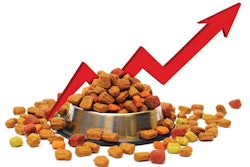
Mexican pet food exports hit record highs in 2020, rising 29.4% in volume terms and reaching 62,437 metric tons. In current dollar terms, exports rose 14.9%.
Pet food imports into Mexico also peaked in 2020, increasing 10.6% in volume terms and totaling 62,634 metric tons. Yet value growth rose just 1.4%. Therefore, the trade balance was slightly negative, unlike in past years where the balance reached sizeable deficits.
Opening new pet food export markets in Central America
The new record came partially from Mexican producers discovering new markets in Central America, a region that is becoming a diverse yet appealing market. Destination countries for Mexican pet food exports in 2020 were Guatemala, with 25% of the total exported volumes; Costa Rica, with 22%; El Salvador, with 11%; and Panama, with 10%. Together, they cumulated 75% of total Mexican pet food exports.
It is worth noting that Mexico also sent 4% of its total exports to the U.S. Most Mexican exports to that country comprise premium products and treats, unlike exports to Central America, which are mainly economy-priced dry dog food.
Imports mostly premium pet foods or intracompany supplies
Pet foods imported into Mexico are usually premium products from the U.S., accounting for 82.3% of total imports in 2020. The biggest individual player is Royal Canin, followed by other emerging companies also sending premium products. Another portion of imports is intracompany, meaning that the Mexican branch of a global company receives pet food products from its North American counterpart.
Notably, the average price of imported pet foods was much higher than that of exports. In 2020, the average price per kilo was around US$2 (CIF, or cost-insurance-freight price), while the average price per kilo for Mexican exports to Central America reached just US$1.1 dollars per kilo (FOB, or free-on-board price).
Central America with good prospects
As Mexico is increasing exports to Central America, domestic producers are likely also increasing their stakes in their local markets. Currently, most pet food markets in the region are underdeveloped, as the product array is limited compared to that of developed markets. Yet, with the increasing demand from abroad, Central America will soon reach a new height in terms of competition, giving consumers more price alternatives and wider product varieties.

















